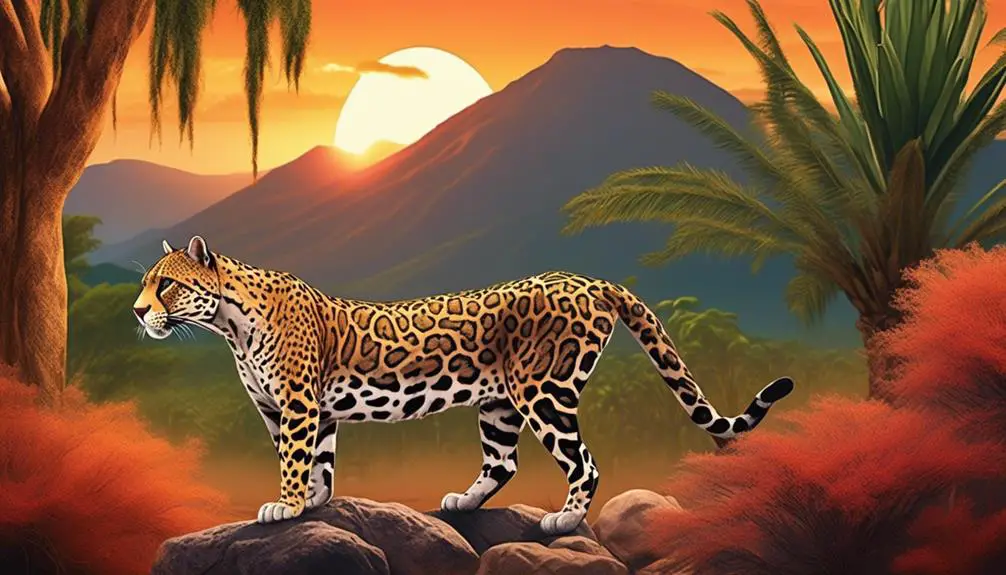Step into the untamed wilderness of Mexico and prepare to be captivated by the remarkable diversity of wild cats that roam these lands. The six types of feline species found here will transport you to a world where power, agility, and adaptability reign supreme.
As you embark on this journey, you will witness the awe-inspiring athleticism of the puma, marvel at the rising population of the bobcat, and uncover the secrets of the elusive jaguar. But that’s not all – there are two more intriguing species waiting to be discovered.
So, are you ready to venture deeper into the mysterious realms of the ocelot and the margay? Join us as we unravel the mysteries of these mesmerizing creatures and uncover their conservation status in this enchanting habitat.
Puma
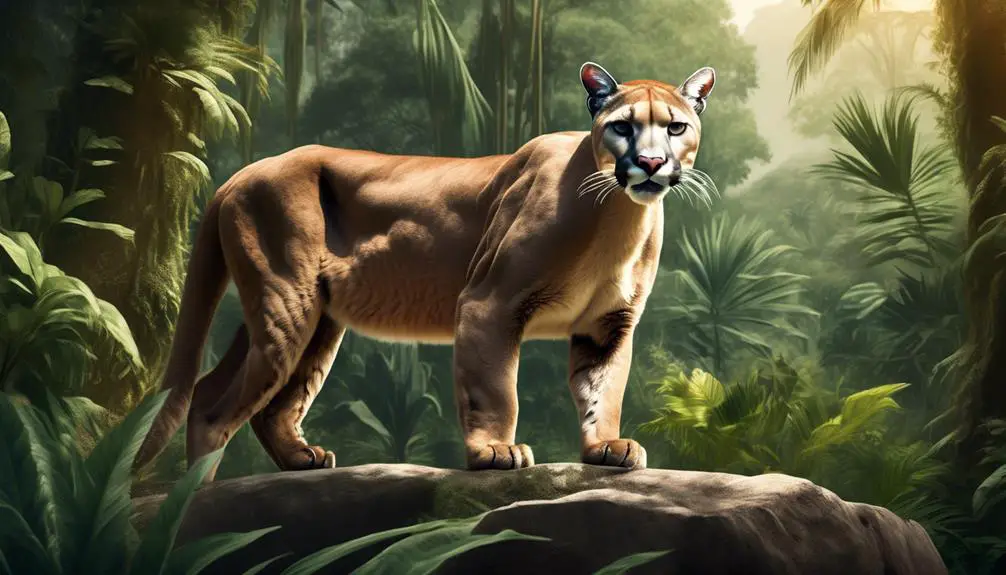
The Puma, also known as the cougar or mountain lion, is a highly adaptable and athletic wild cat with a declining conservation status. It stands at a height of 24-30 inches and weighs around 136 lbs. Pumas have the largest range of any New World cat, stretching from the Yukon in Canada to the tip of South America. These majestic creatures are known for their remarkable athletic abilities, excelling in swimming, climbing, and leaping. Despite their impressive skills, their conservation status is on the decline.
Pumas are solitary animals and are primarily active during twilight and nighttime hours. They’ve a diverse diet, preying on a wide variety of animals, including deer, elk, and small mammals. Pumas are highly adaptable to different habitats, ranging from mountains and forests to deserts and grasslands. However, habitat loss and fragmentation, as well as conflicts with humans, pose significant threats to their survival.
Efforts are being made to conserve and protect the puma population. Conservation organizations are working towards creating protected areas and promoting coexistence between pumas and humans. By raising awareness and implementing conservation strategies, we can ensure the long-term survival of these magnificent creatures in the wild.
Bobcat
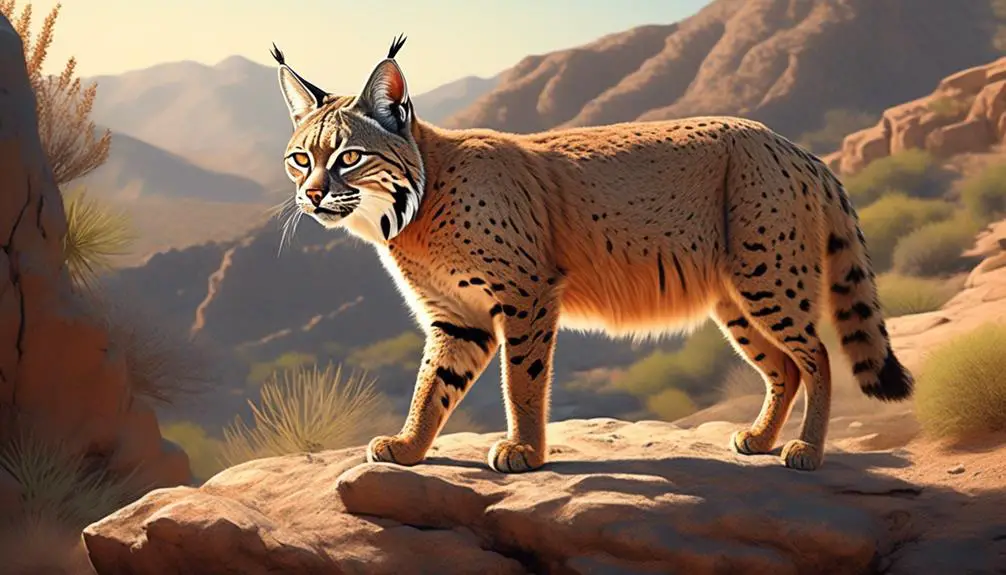
The bobcat, also known as Lynx rufus, is a medium-sized wild cat found in a diverse range of habitats throughout Mexico. They’re highly adaptable creatures, able to thrive in various ecosystems including forests, deserts, and mountains.
Bobcats are skilled hunters, employing a variety of hunting techniques such as stalking, pouncing, and ambushing their prey. Despite facing some threats to their population, bobcat numbers remain stable thanks to their ability to adapt and take advantage of different hunting opportunities.
Habitat and Range
Bobcat, a medium-sized wild cat found in North America, has a diverse and expansive natural range that extends from southern Canada to northern Mexico. They inhabit a variety of habitats including forests, deserts, swamps, and even urban areas.
Bobcats are adaptable and can thrive in both heavily wooded regions and open grasslands. They’re known to prefer areas with dense vegetation for cover and hunting.
Bobcats are territorial animals and require large home ranges to meet their needs. The size of their territory can vary depending on factors such as food availability and population density.
Bobcats are excellent climbers and swimmers, which allows them to navigate their range with ease. They’re well adapted to their environment and have been able to successfully adapt to human-dominated landscapes.
Hunting Behavior
As we shift our focus to the hunting behavior of the bobcat, it’s important to explore how this medium-sized wild cat utilizes its adaptable nature and physical capabilities to successfully procure prey within its extensive range.
The bobcat is known for its stealth and patience when hunting. It relies on its exceptional eyesight, acute hearing, and excellent sense of smell to locate prey. Once a target is identified, the bobcat will stalk its prey, using its powerful legs to silently move through the vegetation.
With a burst of speed, it pounces on its unsuspecting victim, delivering a quick and lethal bite to the neck or head. The bobcat’s hunting technique is highly efficient, allowing it to successfully capture a wide variety of prey, including small mammals, birds, reptiles, and even larger animals such as deer.
Its adaptability and hunting prowess have contributed to the bobcat’s thriving population and stable conservation status.
Population and Conservation
With its adaptable nature and thriving population, the bobcat remains a key focus in discussions about population and conservation efforts.
Bobcats have a diverse and expansive natural range that spans from southern Canada to northern Mexico. Unlike some other wild cat species in Mexico, the conservation status of bobcats is considered stable. This is primarily due to their adaptability and opportunistic hunting behavior.
Bobcat populations are increasing, as they’re able to thrive in a variety of habitats, including forests, deserts, and even suburban areas. However, despite their stable population, bobcats still face threats such as habitat loss and fragmentation.
Conservation efforts are focused on protecting and preserving their habitats, as well as implementing measures to minimize human-wildlife conflicts.
Jaguar
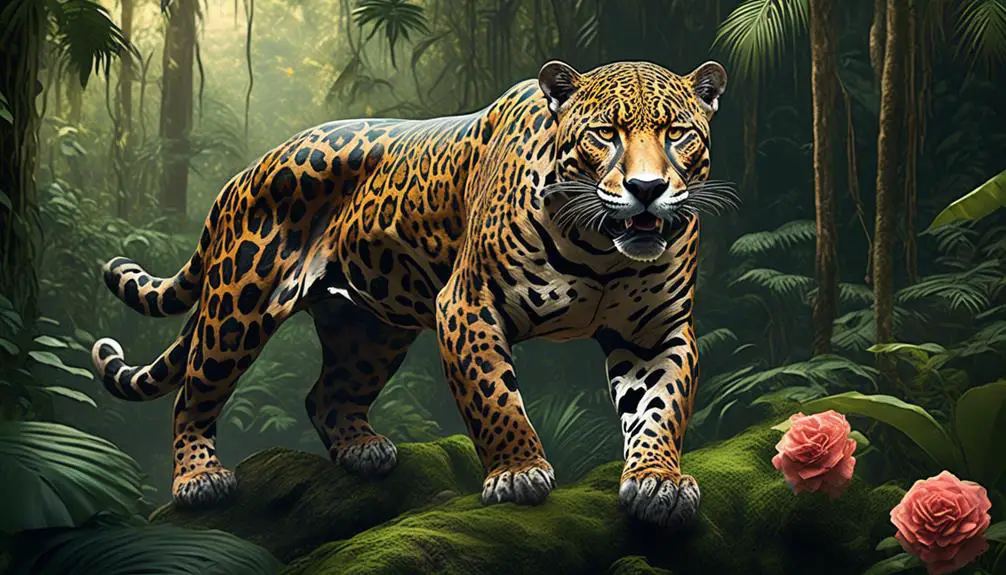
The Jaguar, with its robust build and striking coat pattern, is a large and powerful wild cat found in a diverse range of habitats throughout the southern United States, Central America, and South America. Standing at a height of 26 to 29 inches, and weighing between 70 and 304 pounds, the Jaguar is known for its impressive size and strength. However, despite its formidable nature, the Jaguar is facing a declining population and is listed as a species of conservation concern.
Jaguars have a wide distribution range, which includes the southern United States, as well as various countries in Central and South America. They’re known for their ability to adapt to different environments, from dense rainforests to open grasslands. They’re excellent climbers and swimmers, allowing them to navigate through their habitats with ease.
Jaguars are primarily ground hunters, employing ambushing tactics to capture their prey. Their diet consists of a variety of animals, including deer, peccaries, and even caimans. Their powerful jaws enable them to deliver a lethal bite, puncturing the skulls of their prey.
The decline in Jaguar populations can be attributed to various factors, including habitat loss, poaching, and conflicts with humans. Efforts are being made to conserve and protect these majestic cats, as they play a crucial role in maintaining the balance of their ecosystems. By understanding the biology and behavior of Jaguars, we can work towards ensuring their survival in the wild.
Jaguarundi
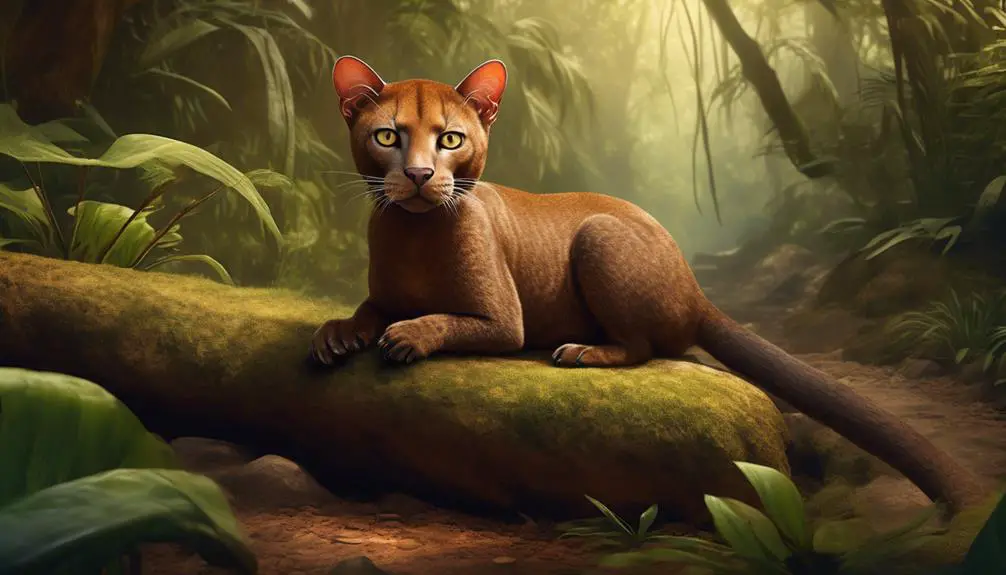
The Jaguarundi is a small wild cat species found in Mexico and other parts of Central and South America. This species prefers dense ground cover and can be found in lowland habitats.
Jaguarundis have a height range of 10-14 inches and weigh between 6.6-15 lbs.
They’re currently facing a declining conservation status, highlighting the need for conservation efforts to protect their habitat and ensure their survival.
Habitat and Range
Jaguarundis, declining in population, inhabit the lowlands across a vast range stretching from northern Mexico to central Argentina. These small wild cats prefer dense ground cover and spend much of their time on the ground. They have a unique habitat and range compared to other wild cats in Mexico. To provide a clearer understanding, let’s explore their habitat and range in a table:
Habitat and Range of Jaguarundis:
| Habitat | Range |
|---|---|
| Lowlands | Northern Mexico to central Argentina |
Jaguarundis thrive in the lowland regions, where they can find suitable cover for hunting and protection. This stretch of land allows them to establish territories and roam freely. However, their declining population calls for increased conservation efforts to ensure the preservation of their unique habitat and range. Understanding their specific habitat requirements is crucial for implementing effective conservation strategies.
Physical Characteristics
With their unique physical characteristics, the Jaguarundi stands out among the wild cats of Mexico. This small-sized cat has a height ranging from 10 to 14 inches and weighs between 6.6 and 15 pounds.
The Jaguarundi’s body is long and slender, with short legs and a small head. Its fur is sleek and uniform, typically displaying a reddish-brown or dark gray coloration. One distinctive feature of the Jaguarundi is its long, low-set tail, which is often darker in color than the rest of its body.
This cat’s physical adaptations allow it to thrive in its preferred habitat of dense ground cover. Overall, the Jaguarundi’s physical characteristics make it an intriguing and unique member of Mexico’s wild cat population.
Conservation Status
As we shift our focus to the conservation status of the Jaguarundi, it is important to examine the current state of this unique wild cat species in Mexico. The Jaguarundi, with a height ranging from 10 to 14 inches and weighing between 6.6 to 15 pounds, is a small carnivorous felid found in the lowlands from northern Mexico to central Argentina. Unfortunately, the conservation status of the Jaguarundi is declining. This decline can be attributed to habitat loss and fragmentation due to human activities, such as deforestation and urbanization. Additionally, the species faces threats from hunting and road mortality. Efforts are being made to conserve the Jaguarundi, including the establishment of protected areas and the implementation of conservation programs to promote its survival. However, continued conservation efforts are crucial to ensure the long-term survival of this unique wild cat species in Mexico.
| Conservation Status | Height (inches) | Weight (lbs) |
|---|---|---|
| Declining | 10-14 | 6.6-15 |
Ocelot
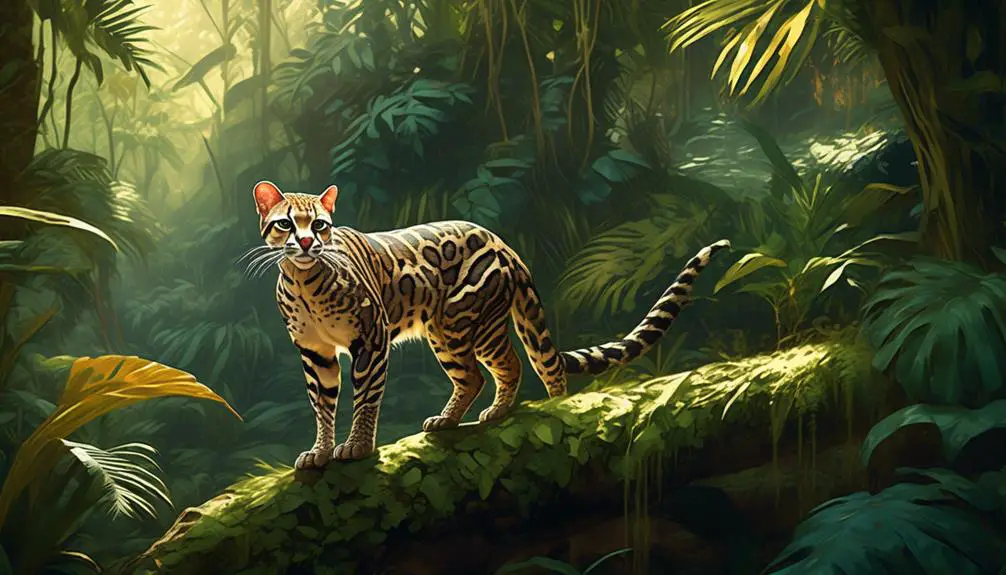
The ocelot, a declining wild cat species, is known for its height ranging from 16 to 20 inches and weight ranging from 17 to 33 lbs. This medium-sized cat has a sleek and robust body, with short legs and a long tail. Its fur is typically yellowish or reddish-brown, marked with dark spots that form rosettes along its body. The ocelot’s range is vast, encompassing altitude cloud forests, mangroves, and other areas of dense vegetation throughout Mexico and Central and South America.
Ocelots are opportunistic carnivores, feeding on a variety of prey including rodents, birds, reptiles, and small mammals. They’re primarily ground hunters, using their keen sense of sight and hearing to locate their prey. Ocelots are solitary animals and their territories can range from 5 to 30 square miles, depending on the availability of resources.
Unfortunately, the ocelot population is declining due to habitat loss, illegal hunting, and the fragmentation of their habitats. Deforestation, urbanization, and agricultural expansion are major threats to their survival. Conservation efforts are crucial to protect the remaining ocelot populations and their habitats. These efforts include the establishment of protected areas, habitat restoration, and raising awareness about the importance of conserving this iconic species.
Margay
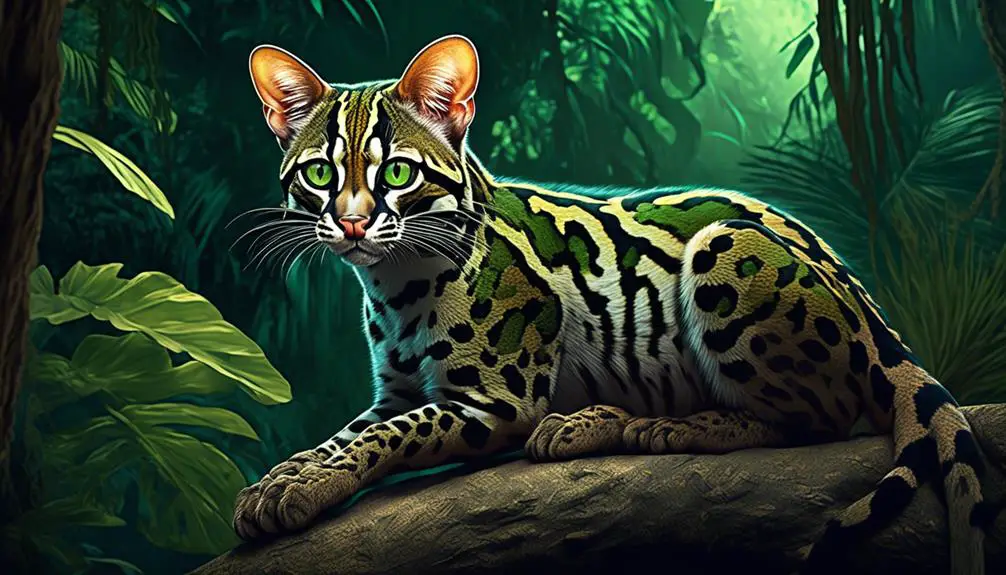
The Margay, another declining wild cat species found in Mexico and Central and South America, is known for its compact stature, measuring only 12 inches in height and weighing between 5 and 11 lbs. This small size allows the Margay to navigate through the dense forest canopies with ease. Its body is slender and agile, with long legs and a long, bushy tail that aids in balance while leaping from branch to branch. The Margay’s fur is beautiful and distinct, featuring a unique pattern of dark spots or rosettes on a tawny background.
Margays are primarily arboreal, spending most of their time in the trees. They’ve adapted to this lifestyle with several physical characteristics. Their flexible ankles allow them to rotate their hind feet 180 degrees, enabling them to climb down trees headfirst. In addition to their impressive climbing abilities, Margays are skilled jumpers, capable of leaping up to 12 feet horizontally. These adaptations make them highly efficient hunters in the treetops, where they prey on small mammals, birds, and even reptiles.
Unfortunately, the Margay population is declining due to habitat loss and fragmentation caused by deforestation. Their reliance on intact forest habitats makes them particularly vulnerable to these threats. Conservation efforts are crucial to protect the remaining Margay populations and their habitats. Strict enforcement of anti-poaching laws and the creation of protected areas are essential steps towards preserving this unique and beautiful species.

Erzsebet Frey (Eli Frey) is an ecologist and online entrepreneur with a Master of Science in Ecology from the University of Belgrade. Originally from Serbia, she has lived in Sri Lanka since 2017. Eli has worked internationally in countries like Oman, Brazil, Germany, and Sri Lanka. In 2018, she expanded into SEO and blogging, completing courses from UC Davis and Edinburgh. Eli has founded multiple websites focused on biology, ecology, environmental science, sustainable and simple living, and outdoor activities. She enjoys creating nature and simple living videos on YouTube and participates in speleology, diving, and hiking.

